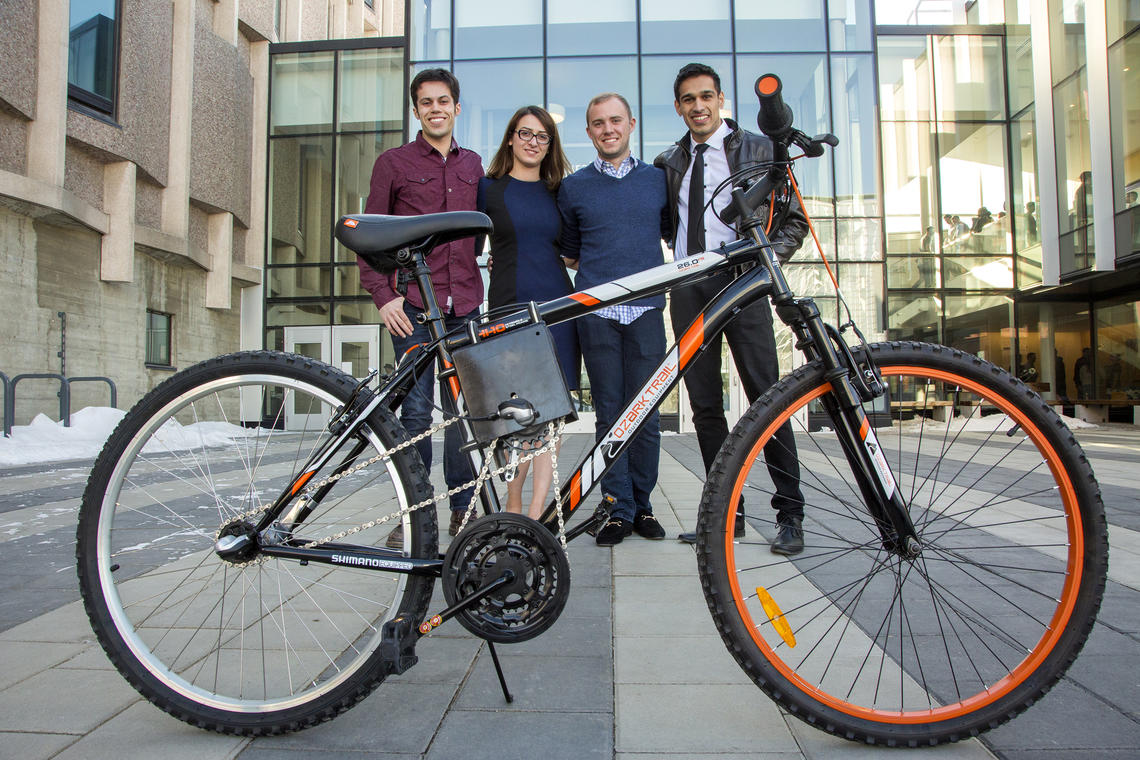April 10, 2018
Necessity, neat ideas the mother of invention at 2018 design fair

Engineering students Evan Magnusson, Nazanin Moghtaderi, Alex Robertshaw and Parth Thakurdesai.
Colleen de Neve, for the University of Calgary
Even in a normal winter, a bicycle able to withstand the corrosive appetite of ice and snow is a pretty sound idea.
But this year in Calgary, where snowfall records have been broken and spring remains a cruel rumour, engineering a bicycle specifically intended for cold-weather commuting seems like a stroke of pure genius.
“A normal bicycle would only last about two years in this weather,” explains Parth Thakurdesai, one of the four-member team who designed the nine-speed Winter Commuter Bike.
“This bike offers full enclosure of the mechanical components, including the gears, protecting them from ice and snow.”
One of dozens of projects at design fair
And a bicycle built for “brrrr” was just one of the dozens of projects on display this year at the 2018 Engineering Design Fair, hosted at the University of Calgary’s Canadian Natural Resources Limited Engineering Complex on April 3.
The annual fair, which was sponsored this year by Crescent Point Energy and supported by NSERC Design Chairs Bob Brennan and Simon Li, is a reflection of a key Schulich School of Engineering teaching philosophy: future engineers learn best by doing.
“Our project gave us to the opportunity to explore a subject we’re passionate about, and use our engineering skills to design an impactful solution to further space exploration,” says Laura Fader, part of a prize-winning team of chemical engineering students who developed a method to generate oxygen on Mars.
“We were able to push ourselves to create a feasible design on another planet, and make what seems like a fantasy project a reality.”
All engineering students take part in final year
In their final year, all Schulich undergraduates spend months taking their original ideas from concept to design and prototype as part of the Capstone Design course, and on fair day, the campus community and members of the public are invited to tour nearly 120 projects.
Among this year’s creative crop was a transformer inspection robot, a custom motorcycle luggage system, and an electrical-assist manual wheelchair, all imagined, designed and created by students.
Other standout prototypes included:
- DNA sequencer: This hand-held device quickly identifies human DNA from a sample swab — and then throws it away. What’s left is invasive DNA, helping scientists ID harmful viruses like Ebola in a matter of hours, rather than days or weeks.
- Glenmore Trail variable speed trial: This team worked with The City of Calgary to determine what variable speed limits can do to reduce collisions and congestion on one of the city’s major freeways.
- Trial tracker: A computer app engineered to match patients with medical trials, saving physicians from guesswork and time-consuming research when it comes to providing new hope for people in their care.
- Trash Splash: This team showed off their Trash Splash project, a novel water-powered machine that can remove plastics from the world’s most polluted rivers, before that plastic can reach the world’s oceans.
- Aviation biofuel: Producing a clean-burning biofuel will help reduce the environmental footprint and energy consumption of the aviation industry. The team’s goal is to produce Jet A-1 biofuel from camelina oil to supply a portion of the Calgary International Airport’s fuel usage.
The winners were chosen from each department by a roving panel of industry judges.
They included a prefabricated wind turbine foundation; a solution to deliver pre-hospital vital signs to doctors; a comparison and analysis of the minimum curvature and advanced spline curve methods for wellbore positioning; a racecar alignment rig; a forest fire suppression system; and Saskatchewan instow Unit ASP/polymer flood implementation.
Take a look at the slideshow here.
